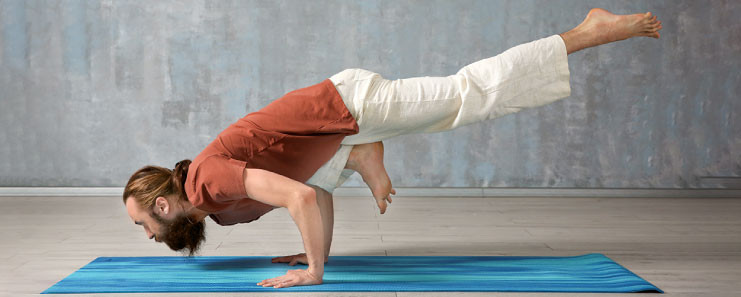What are 7 chakras in human body? How important are they for us? There are seven chakras or energy centers in human body through which our vital energy or prana shakti flows. Sometimes, these energy channels get blocked and this leads to illness and disturbances in the body’s natural processes. It is important to understand what each chakra represents and what we can do to keep this energy flowing freely. This is possible when the chakras are balanced.

How yoga helps to balance 7 chakras in body
When a chakra i.e. wheel of energy is stuck, movement can help release the prana (energy). Yoga postures are a great way to release stale or stuck energy from the body because they invite fresh, vital energy back in through poses and the breath.
The practice of yoga ultimately leads us to a state of union, which is possible when we create a state in our body where energy can flow freely from the base of the spine (the Root Chakra), through and beyond the top of the head (the Crown Chakra). When energy can flow freely through us like this, we can achieve a state of union with the cosmic energy, which flows through all living things. When each chakra is unblocked, it spins like a wheel, hence the word ‘chakra’ meaning ‘wheel’ in Sanskrit.
Since yoga is both a physical and spiritual practice, yoga poses are not only exercises for your body but also your mind, emotions, and spirit, making it the perfect practice for balancing your chakras.

The 7 chakras in human body
Let’s explore the seven chakras in our body, how they affect the body, what imbalance does to our personality and organs, and how to set it right by balancing the chakras with yoga asanas or poses.
- Muladhara Chakra
- Swadishthana Chakra
- Manipura Chakra
- Anahata Chakra
- Vishuddhi Chakra
- Ajna Chakra
- Sahasrara Chakra
1. Muladhara Chakra
Element: Earth
Color: Red
Mantra: LAM
Location: Base of the spine between the anus and genitals
How it affects the body: The Muladhara Chakra influences the health of the bones, teeth, nails, anus, prostate, adrenals, kidneys, lower digestive functions, excretory functions, and sexual activity.
Imbalance in the chakra leads to tiredness, poor sleep, lower back pain, sciatica, constipation, depression, immune-related disorders, obesity, and eating disorders.
| The behavioral impact of the imbalance: | Traits of a balanced chakra: |
| ungrounded fear | a feeling of being grounded and centered |
| anger | sense of commitment and independence |
| low self-esteem | energy and vitality |
| insecurity | strength and stillness |
| obsession with comfort | ability to digest food well |
| possessiveness |
Poses that balance Muladhara chakra: Grounding-into-feet poses like
o Mountain Pose
o Side-Angle Pose
o Warrior Pose
o Standing Forward Bend
o Bridge Pose
2. Swadishthana Chakra
Element: Water
Color: Orange
Mantra: VAM
Location: Situated at the base of the pubis between the genitals and the sacral nerve plexus
How it affects the body: The Swadishthana Chakra deals with the individual’s emotional identity, creativity, desire, pleasure and self-gratification, procreation, and personal relationships.
It governs the sexual organs, stomach, upper intestines, liver, gallbladder, kidney, pancreas, adrenal glands, spleen, middle spine, and autoimmune system.
An unbalanced Swadishthana Chakra leads to lower back pain, sciatica, decreased libido, pelvic pain, urinary problems, poor digestion, low resistance to infection and viruses, tiredness, hormonal imbalances, and menstrual problems.
| The behavioral impact of imbalance: | Traits of a balanced chakra: |
| irritability | a feeling of compassion and friendliness |
| shyness | intuitiveness |
| guilt | vitality |
| tendency to blame | sense of belonging |
| sexual obsession | good sense of humor |
| lack of creativity |
Poses that balance Swadishthana chakra: Hip opening poses like
o Standing Wide Forward Bend
o Sitting Wide Forward Bend
o Bound Angle Pose
3. Manipura Chakra
Element: Fire
Color: Yellow
Mantra: RAM
Location: At the level of the umbilicus corresponding to the gastric or solar plexus
How it affects the body: Manipura Chakra deals with a sense of belonging, mental understanding of emotions, and defines self-esteem in an individual.
It governs the effective functioning of the upper abdomen, gallbladder, liver, middle spine, kidney, adrenals, small intestines, and the stomach.
An unbalanced Manipura Chakra may lead to diabetes, pancreatitis, adrenal imbalances, arthritis, colon diseases, stomach ulcers, intestinal tumors, anorexia/bulimia, or low blood pressure.
| The behavioral impact of the imbalance: | Traits of a balanced chakra: |
| lack of self-esteem | energetic and confident nature |
| timidness | intelligence |
| sense of depression | high productivity |
| fear of rejection | improved focus |
| inability to make decisions | good digestion |
| judgmental and angry nature | |
| hostility |
Postures that balance Manipura chakra: Heat-building poses like
o Sun Salutation Pose
o Warrior Pose
o Backbends like Bow Pose
o Twists like Sitting Half-spinal Twist
o Abdominal-strengthening poses like Boat Pose

4. Anahata Chakra
Element: Air
Colors: Green or pink
Mantra: YAM
Location: On the cardiac plexus in the region of the heart
How it affects the body: Anahata Chakra affects a person’s social identity and influences traits like trust, forgiveness, unconditional love, wisdom, compassion, and issues of the soul.
It deals with the functioning of the heart, rib cage, blood, circulatory system, lungs and diaphragm, thymus gland, breasts, esophagus, shoulders, arms, hands.
An imbalance can cause issues related to the thoracic spine, upper back and shoulder problems, asthma, heart conditions, shallow breathing, and lung diseases.
| The behavioral impact of the imbalance: | Traits of a balanced chakra: |
| difficulty with love | the feeling of completeness and wholeness |
| lack of hope, compassion, and confidence | compassion |
| feeling of despair | empathy |
| mood variations | friendliness |
| optimism | |
| increased motivation | |
| outgoing nature |
Postures that balance Anahata chakra: Chest-openers like
o Camel Pose
o Cobra Pose
o Fish Pose
o Pranayamas like Alternate Nostril Breathing or Bellow breath
5. Vishuddhi Chakra
Element: Sound or Ether
Color: Blue
Mantra: HAM
Location: On the level of the throat, the nerve plexus of the pharynx region
How it affects the body: Vishuddhi Chakra deals with personality traits like communication, creativity, faith, truthfulness, self-awareness, and expression.
It governs the throat, the thyroid, and parathyroid gland, trachea, cervical vertebrae, vocal cords, neck and shoulders, arms, hands, esophagus, mouth, teeth, and gums.
An unbalanced Vishuddhi Chakra causes thyroid dysfunctions, sore throat, stiff neck, mouth ulcers, gum or tooth problems, laryngitis, and hearing problems.
| The behavioral impact of the imbalance: | Traits of a balanced chakra: |
| shaken faith | Increased creativity and expressiveness |
| indecisiveness | effective communication skills |
| weak will-power | contentedness |
| lack of expressiveness | good listening abilities |
| lack of creativity | |
| proneness to addictions |
Postures that balance Vishuddhi chakra:
o Fish Pose
o Cat Stretch
o Neck stretches like Balasana and Supported Shoulder Stand
o Bridge Pose
o Plow Pose
6. Ajna Chakra
Element: Light
Colors: Indigo
Mantra: AUM or OM
Location: Between the eyebrows (third eye)
How it affects the body: Ajna Chakra deals with self-awareness, wisdom, intellect, clairvoyance, implementation of ideas, detachment, insight, understanding, and intuitive reasoning.
It governs the functions of the brain, eyes, ears, nose, pituitary gland, pineal glands, and the neurological system. Any imbalance could lead to headaches, nightmares, eyestrain, learning disabilities, panic, depression, blindness, deafness, seizures, or spinal dysfunctions.
| The behavioral impact of the imbalance: | Traits of a balanced chakra: |
| poor judgment | clear thinking |
| confusion | healthy imagination |
| fear of truth | strong intuition power |
| indiscipline | good concentration |
| concentration issues | improved focus |
| proneness to addictions |
Postures that balance Ajna chakra:
o Child Pose
o Meditation
o Seated Yoga Mudra
o Eye exercises like palming the eyes and rotational viewing
7. Sahasrara Chakra
Element: Conscience
Colors: Violet or White
Mantra: Silence
Location: Crown of the head
How it affects the body: Sahasrara Chakra influences intuitive knowledge, connection to spirituality, integration of mind-body-spirit, and conscious awareness.
It governs the center of the head and midline above the ears, brain, nervous system, and the pineal gland.
An imbalance in the Sahasrara Chakra causes chronic exhaustion and sensitivity to light and sound.
| The behavioral impact of the imbalance: | Traits of a balanced chakra: |
| lack of purpose | a feeling of oneness with the universe |
| identity crisis | open-mindedness |
| disbelief in any spiritual practices, or devotion | intelligence |
| lack of inspiration | thoughtfulness |
| sense of fear | receptivity to thoughts and ideas |
| materialistic nature | an overall harmonious personality |
Postures that balance Sahasrara chakra:
o Balancing poses like Tree Pose that bring awareness to the body
o Yoga Mudra
Imbalance is a part of life, however, regular practice of yoga asanas will help you balance your chakras, enabling you to live a fulfilled, contented, and happy life in the pink of health!
You can watch a video on the purification of chakras by Gurudev Sri Sri Ravi Shankar





